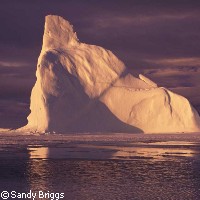Polar warming definitely caused by humans, scientists demonstrate
An international team of scientists has demonstrated for the first time that rising temperatures in the Arctic and Antarctic are caused by human activity. A number of studies have uncovered evidence of warming at both poles over recent decades; temperatures in the Arctic have risen at twice the global rate over the past half century, leading to a rapid decline in the amount of sea-ice coverage. In the southern hemisphere, scientists have observed rapid warming over the Antarctic peninsula, a trend which is associated with the dramatic collapse of the Larsen B ice shelf in 2002. However, until now it has not been possible to conclusively link warming in the polar regions to human activities. Indeed, in its last report, the IPCC (Intergovernmental Panel on Climate Change) concluded that 'anthropogenic influence has been detected in every continent except Antarctica, which has insufficient observational coverage to make an assessment'. As the IPCC notes, one of the reasons for the lack of a conclusive link is the shortage of data; there are just 100 weather stations in the Arctic and a mere 20 in the Antarctic. Furthermore, data on the Antarctic only goes back as far as the middle of the 20th century, while data on the Arctic goes back some 100 years. Another problem facing scientists attempting to tease out the causes of polar warming is the large natural variability in the polar climate. In this latest study, which is published in the journal Nature Geoscience, researchers from the UK, Japan and the US put together temperature records from across the polar regions. They also ran four reliable climate models, sometimes using only natural factors, such as changes in solar activity and volcanic eruptions, sometimes adding in human activities such as greenhouse gas emissions and stratospheric ozone depletion. Only the models that included human activities were able to accurately predict the observed temperature trends, leading the scientists to conclude that the temperature rises in polar regions cannot be explained by natural variability alone, but are caused directly by human activities. 'Overall, despite the paucity of observations, we find that human-induced warming is detectable in both these regions of high vulnerability to climate change,' the researchers conclude. 'Our results demonstrate that human activities have already caused significant warming in both polar regions, with likely impacts on polar biology, indigenous communities, ice-sheet mass balance and global sea level.' 'This is important work indeed,' comments Dr Alexey Karpechko of the Climatic Research Unit at the University of East Anglia in the UK. 'Arctic warming has previously been emphasised in several publications, although not formally attributed to human activity. However in Antarctica, such detection was so far precluded by insufficient data available.' Dr Karpechko adds that changes in atmospheric circulation caused by the hole in the ozone layer reduced warming over most of Antarctica, making it even harder to detect human-induced changes. Since the ozone layer is expected to recover in the future we may expect increased warming in the Antarctic in the coming years, Dr Karpechko warns.
Countries
Japan, United Kingdom, United States



